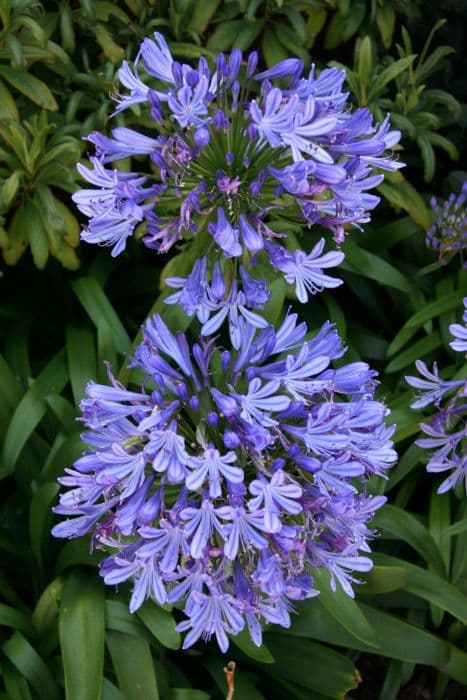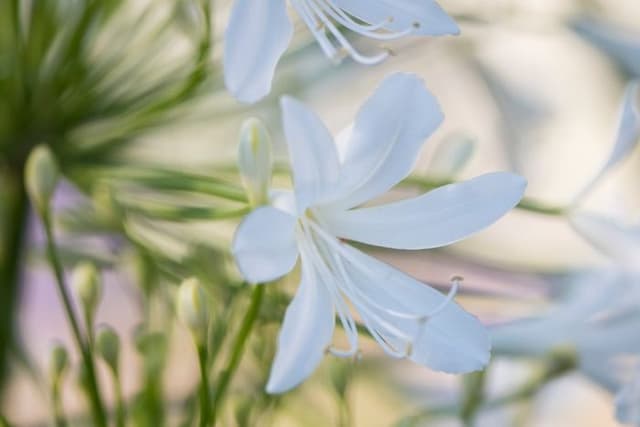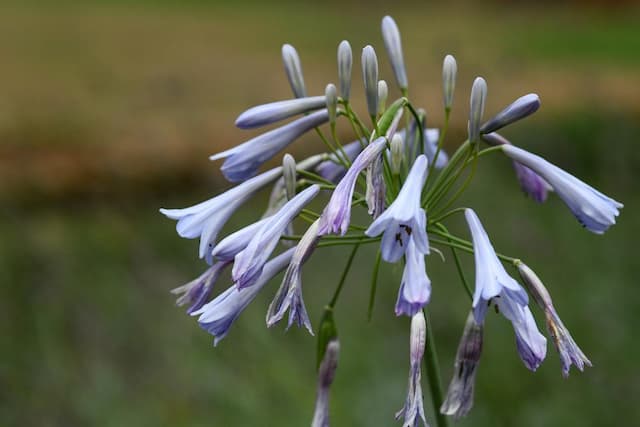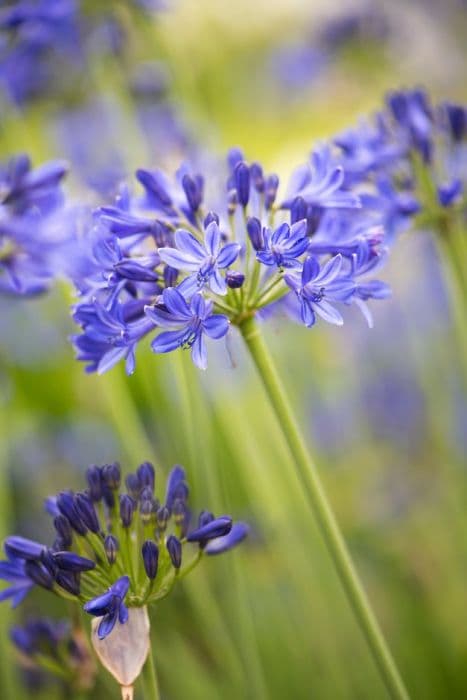African Lily Agapanthus 'Queen Mother'

ABOUT
The Agapanthus 'Queen Mother', commonly known as the African Lily, is a striking perennial plant that boasts a lush, evergreen appearance with long, strap-shaped leaves. These leaves form a dense clump, providing a backdrop for the standout feature of the plant: the eye-catching flowers that bloom on tall stems above the foliage. The flowers themselves are large, rounded clusters or umbels of trumpet-shaped individual florets, carrying a beautiful sky-blue hue that can vary in intensity. These floral spheres provide a spectacular display of color when in bloom, attracting both the eyes of admirers and pollinators such as bees and butterflies. The African Lily's overall aspect is one of both elegance and hardiness, with a disposition that lends well to ornamental garden designs, especially as a border or a focal point in beds and containers.
About this plant
 Names
NamesSynonyms
African Lily, Lily of the Nile, Queen Mother Agapanthus.
Common names
Agapanthus 'Queen Mother'
 Toxicity
ToxicityTo humans
The Lily of the Nile is considered mildly toxic to humans if ingested. The plant contains substances such as saponins that can cause poisoning. Symptoms of poisoning from eating parts of the Lily of the Nile may include nausea, vomiting, abdominal pain, and diarrhea. More severe effects are not generally expected, but it's advisable to seek medical attention if ingestion occurs.
To pets
The Lily of the Nile is toxic to both cats and dogs. If a pet ingests this plant, it could lead to symptoms such as vomiting, diarrhea, nausea, and abdominal pain. In some cases, more severe reactions like tremors or cardiac issues may occur, although that is less common. If a pet has consumed any part of the Lily of the Nile, it's important to contact a veterinarian immediately.
 Characteristics
CharacteristicsLife cycle
Perennials
Foliage type
Evergreen
Color of leaves
Green
Flower color
Blue
Height
3-4 feet (0.9-1.2 meters)
Spread
2-3 feet (0.6-0.9 meters)
Plant type
Bulb
Hardiness zones
8
Native area
South Africa
Benefits
 General Benefits
General Benefits- Easy to care for - Agapanthus 'Queen Mother' is relatively low maintenance, requiring only basic care to thrive.
- Drought-tolerant - Once established, it can handle periods of low water, making it suitable for water-wise gardens.
- Attracts pollinators - The flowers attract bees, butterflies, and other beneficial insects to the garden.
- Long blooming period - It provides a long season of blooms, typically from late spring to summer.
- Landscape versatility - Suitable for borders, container gardening, and as a focal point in the landscape.
- Large showy flowers - The plant produces large, attractive flower heads that can be used as cut flowers.
- Deer resistant - It's not a preferred plant of deer, which can help to keep gardens intact in areas with deer populations.
 Medical Properties
Medical PropertiesThis plant is not used for medical purposes.
 Air-purifying Qualities
Air-purifying QualitiesThis plant is not specifically known for air purifying qualities.
 Other Uses
Other Uses- The Agapanthus, often known as African Lily, can be planted en masse to stabilize soil and prevent erosion on slopes due to its robust root system.
- In coastal gardens, African Lily is resistant to salt spray, making it an ideal choice for seaside planting schemes.
- Agapanthus' tall and striking flower stalks can be used as natural borders or edges in garden design, providing structure to the landscape.
- The African Lily can be planted around swimming pools for aesthetic appeal as its reflection on the water surface enhances the pool's beauty.
- African Lily plants are excellent for container gardening, which allows for their striking flowers to be displayed on patios, balconies, or courtyards.
- As a plant that often blooms around July, the African Lily can be used for garden color themes that celebrate the Fourth of July with its blue and white flowers.
- The African Lily's foliage remains attractive even when not in bloom, offering gardeners a perennial source of lush greenery.
- Agapanthus can be used in dried flower arrangements; their seed heads maintain shape and add an exotic touch long after the blooming season.
- The striking appearance of African Lily flowers makes them a popular choice for thematic gardens, such as moon gardens, where their light-colored blooms stand out in the twilight.
- Flower photographers and enthusiasts often use African Lily as a subject for practicing macro photography due to the intricate details and colors of its blooms.
Interesting Facts
 Feng Shui
Feng ShuiThe Lily of the Nile is not used in Feng Shui practice.
 Zodiac Sign Compitability
Zodiac Sign CompitabilityThe Lily of the Nile is not used in astrology practice.
 Plant Symbolism
Plant Symbolism- Love Letters: The name Agapanthus comes from the Greek words 'agape,' meaning love, and 'anthos,' meaning flower, hence it is often associated with love letters or messages.
- Beauty: The Agapanthus is admired for its striking blue, violet, or white flowers, which represent beauty and admiration.
- Fertility: With its lush, abundant blooms that appear in clusters, the Agapanthus can symbolize fertility and abundance.
- Endurance: The plant is known for its hardiness and ability to thrive in challenging environments, making it a symbol of endurance and perseverance.
- Good Fortune: In some cultures, Agapanthus is believed to bring good luck and is regarded as a token of good fortune.
 Water
WaterLily of the Nile prefers consistent moisture, especially during spring and summer while the plant is actively growing. It should be watered thoroughly once a week, receiving about 1 gallon of water per watering session. In the warmer months, check the soil moisture frequently, as you may need to water more often if the weather is particularly hot or windy. During the winter, when the plant is dormant, reduce the watering to once every two to three weeks, ensuring that the soil does not become completely dry. It's best to water deeply at the base of the plant to encourage deep root growth and avoid shallow, frequent waterings that may not reach the roots effectively.
 Light
LightLily of the Nile thrives in full sun but can also tolerate partial shade. For best growth and bloom production, place the plant in a location where it will receive at least 6 hours of direct sunlight daily. If you live in a particularly hot climate, some afternoon shade can help protect the plant from excessive heat stress. Avoid deeply shaded areas, as insufficient light can lead to poor flowering and a lanky, stretched appearance of the foliage.
 Temperature
TemperatureLily of the Nile is hardy in temperatures as low as 20 to 25 degrees Fahrenheit and can survive brief periods of colder weather with adequate protection. The ideal growing temperature range for this plant is between 60 and 85 degrees Fahrenheit. Excessive heat, particularly when combined with humidity, may lead to stress, so some shade during the hottest part of the day can be beneficial in very warm climates.
 Pruning
PruningPrune Lily of the Nile to remove spent flower stalks and to tidy up the plant's appearance. This can be done immediately after flowering to encourage a clean look and possibly a second flush of blooms. It's also advisable to cut back any damaged or dead foliage in early spring to stimulate new growth. Pruning once a year is typically sufficient, but additional light trimming can be done as needed to maintain the desired shape and size.
 Cleaning
CleaningAs needed
 Soil
SoilLily of the Nile, or Agapanthus 'Queen Mother', thrives best in a soil mix that is well-draining and rich in organic matter. A mixture of two parts loam, one part peat, and one part perlite or sand is ideal. Ensure the soil pH remains between 6.0 and 7.0 to keep the plant healthy.
 Repotting
RepottingLily of the Nile should be repotted every 2 to 4 years to refresh the soil and provide room for growth. However, they bloom better when slightly root-bound, so avoid repotting too frequently.
 Humidity & Misting
Humidity & MistingLily of the Nile prefers moderate humidity levels. While it is adaptable to a range of conditions, maintaining a humidity level around 40-60% is sufficient for this plant's growth.
 Suitable locations
Suitable locationsIndoor
Place Lily of the Nile in a bright spot, away from drafts.
Outdoor
Plant Lily of the Nile in full sun or partial shade.
Hardiness zone
8-10 USDA
 Life cycle
Life cycleAgapanthus 'Queen Mother', or Lily of the Nile, starts as a seed which, once germinated, develops into a seedling. The seedling grows into a vegetative plant with strap-like foliage and establishes a robust root system. At maturity, the plant produces tall flowering stalks topped with spherical clusters of trumpet-shaped, blue to purple flowers during the summer. After blooming, the plant sets seed, which can be dispersed to propagate the next generation. In colder climates, it enters a dormancy phase in winter, where growth slows down or stops until favorable conditions return. Throughout its life, the Lily of the Nile may undergo vegetative propagation through the division of clumps to create new, genetically identical plants.
 Propogation
PropogationPropogation time
Spring-Early Summer
The most popular way to propagate the Agapanthus 'Queen Mother', commonly known as the Lily of the Nile, is through division. This method is ideally performed in the spring before new growth begins. Gardeners should gently lift the clump of the plant from the soil using a spade and then divide the clump into smaller sections. Each section should have at least one or two growing points or shoots and a portion of the root system. After the clump is divided, the sections can be replanted at the same depth they were originally growing. It is important to water the new divisions thoroughly to help establish them. This method allows the plants to recover and start growing quickly during the growing season.









